My Teeth are Decaying at the Gum Line: What You Need to Know

The area near the gum line is naturally more protected and resistant to cavities than other parts of your teeth, like the chewing surfaces. However, it can still decay — and when that happens, it’s often a sign that something unusual is increasing your risk.
Gum line decay tends to become more common with age. And because it can spread quickly and cause serious damage, it's crucial to catch it early.
If you're dealing with tooth decay around your gums, you're in the right place. This article covers everything you need to know.
Gum line decay tends to become more common with age. And because it can spread quickly and cause serious damage, it's crucial to catch it early.
If you're dealing with tooth decay around your gums, you're in the right place. This article covers everything you need to know.
In this article:
1. What’s So Different About Tooth Decay at the Gum Line?
2. The Different Types of Tooth Decay Near the Gum Line
3. Why Are Cavities at the Gum Line More Common When Gums Recede?
4. Why Tooth Decay at the Gum Line Might Signal a Higher Cavity Risk?
5. How Can Gumline Tooth Decay Evolve if Left Untreated?
6. Early Signs of Tooth Decay at the Gum Line
7. How to Stop Tooth Decay at the Gum Line Before It’s Too Late
8. Professional Treatment Options
9. Takeaway
What’s So Different About Tooth Decay at the Gum Line?
When tooth decay appears near the gum line, it typically starts between the teeth and can extend down to the root surfaces.The smooth front visible surfaces are overall more protected — but that doesn’t mean they’re completely immune to cavities.
Gumline cavities on the front-facing surfaces can occur in two different situations:
- With gum recession (root decay) – More common in older adults, as gums naturally start to recede with age. Once the roots are exposed and lose the protection of gum tissue, they become much more vulnerable to decay (see picture below).
- Without gum recession – Less common, but it can still happen even in younger adults with healthy-looking gums. When they do appear, it’s often a warning sign of a higher risk for cavities (as shown below).

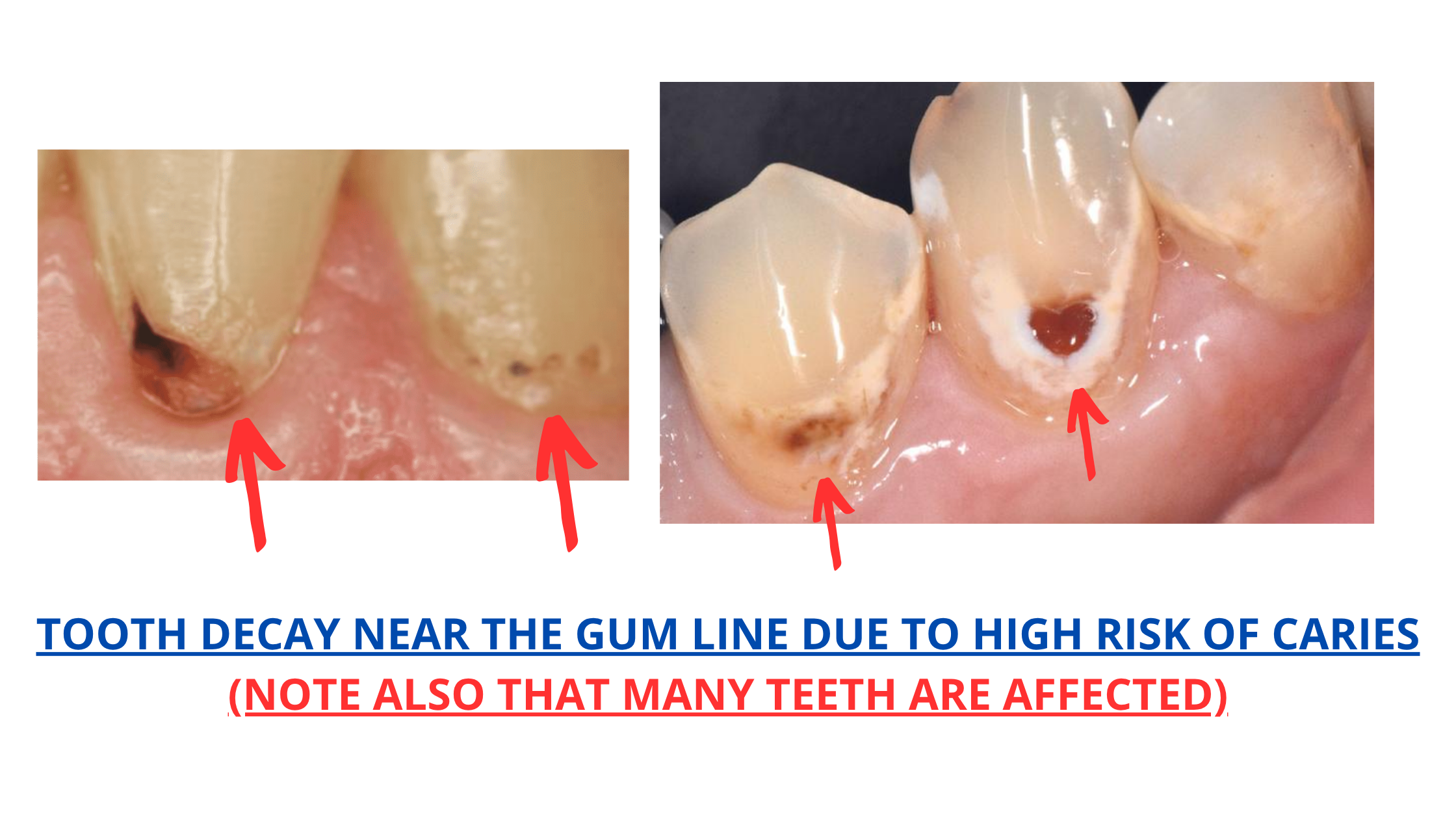
Why is gumline tooth decay a red flag for higher risks?
Because the area above the gum line is normally smooth, easy to clean, and constantly exposed to your toothbrush and saliva. It doesn’t trap food and plaque like the deep grooves on chewing surfaces. So, it's not the typical site for tooth decay to start.
If cavities are forming even in these low-risk areas, it usually means something is off — such as poor oral hygiene, frequent sugary snacks or drinks, dry mouth (low saliva flow), or receding gums.
That’s why decay in these areas often spreads to multiple teeth and becomes more aggressive if left untreated.
The Different Types of Tooth Decay Near the Gum Line
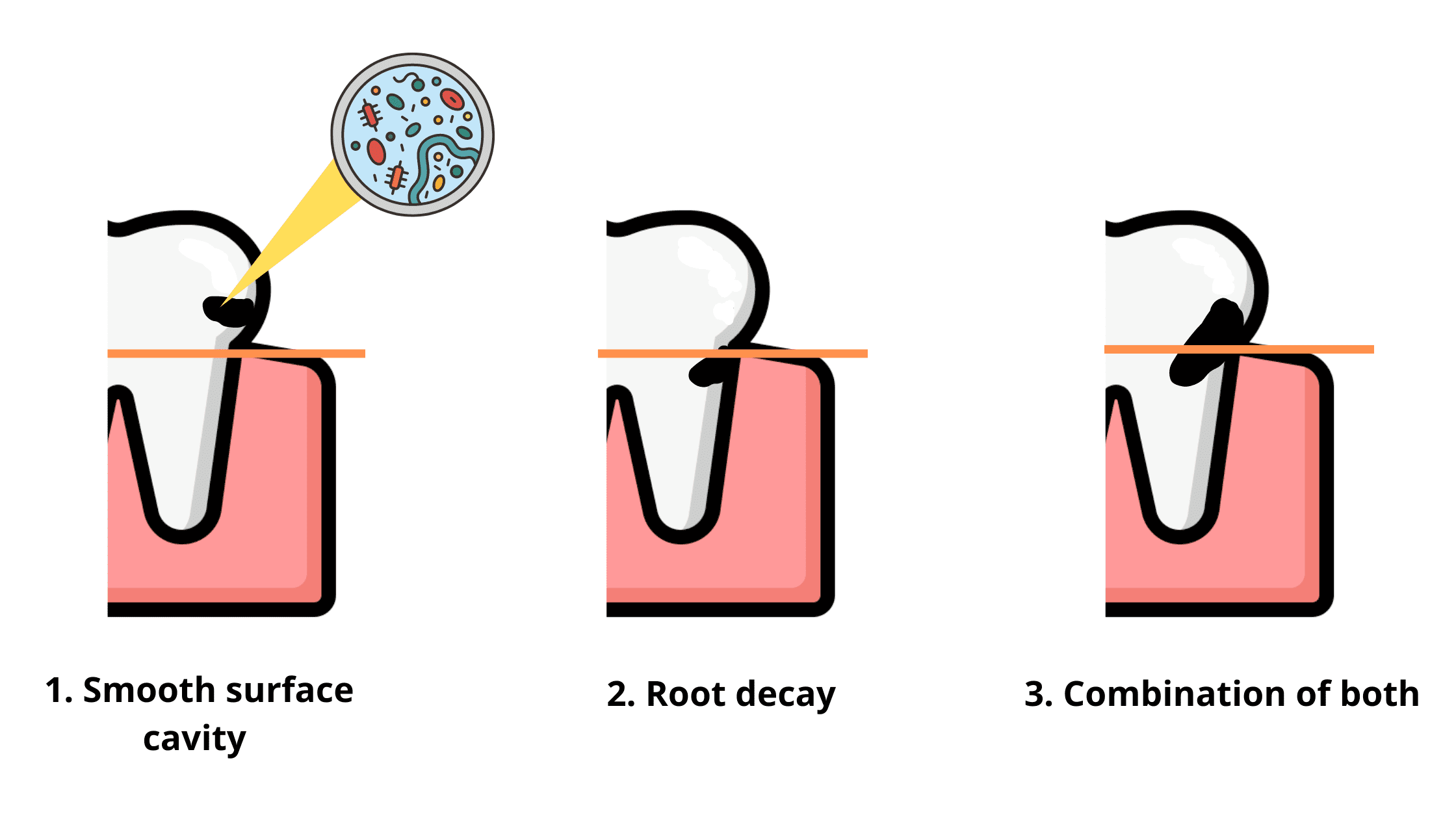
Tooth decay at the gum line can appear in three different forms, depending on where it starts and its position in relation to the gums:
1. Smooth-Surface Caries
These form above the gum line, most often between the teeth. However, they can also appear on the front surfaces if you're at high risk. They're the easiest to treat and restore.
2. Root Caries
These often occur when the gums recede or when smooth surface decay spreads below the gum line into the roots. Root decay is much more difficult to restore, and often progresses faster due to the softer nature of root surfaces.
3. Combined Damage
This is a combination of both, where tooth decay affects both the smooth and root surfaces, often requiring more complex treatment.
Why Are Cavities at the Gum Line More Common When Gums Recede?
Tooth decay isn’t just about forgetting to brush or eating too much sugar — it’s a more complex process that involves several factors. One of them is gum recession.Gum recession and root decay often occur together, and both become more common with age.
When the gums pull back from the teeth, they expose the roots to the harsh acidic environment of the mouth. And once the roots are exposed, they’re more likely to decay — here’s why:
- Root surfaces are rougher than enamel, so they trap plaque and food more easily.
- Exposed roots are often overlooked during brushing and are harder to keep clean.
- Roots are only covered by a thin layer of soft tissue called cementum. This makes them more vulnerable to decay, which can spread twice as fast as it does in the enamel-covered part of the tooth.
That's why, as gums recede with age, root decay often follows. Combine this with other age-related factors, like reduced saliva flow, tooth wear, and poor oral hygiene, and the risk increases even further.
If you spot decay near your gum line — especially on the roots — don’t wait. These cavities can grow quickly and often don’t cause pain until significant damage has been done.
Why Tooth Decay at the Gum Line Might Signal a Higher Cavity Risk?
The smooth front surfaces of your teeth are not common spots for tooth decay. As we've said earlier, these areas are naturally self-cleaning — they don’t trap much plaque and are easily reached and cleaned by your toothbrush and saliva.So if cavities are forming there, it’s often a red flag that your overall risk of decay is high. In many cases, other teeth may already be affected or will be soon.
Aside from receding gums, here are some of the most common risk factors:
Poor Oral Hygiene
Inconsistent brushing, improper technique, or skipping flossing allows plaque — the main cause of cavities — to build up. If not removed regularly, this sticky film can gradually eat away at your tooth’s minerals, eventually leading to decay.
Brushing Too Aggressively or Using a Hard Toothbrush
Brushing with too much force or using a hard-bristled brush can cause tooth wear near the gum line, creating a “V”-shaped notch known as tooth abrasion. This damage can become a trap for plaque and bacteria.
Aggressive brushing can also lead to gum recession, exposing the roots and increasing the risk of root decay.
A Sugar-Rich Diet
Sugar feeds the bacteria that cause cavities. If your diet is high in sugars and carbs, low in minerals, or you snack frequently between meals, your mouth becomes more acidic — a perfect environment for decay to thrive.
Lack of Saliva or Dry Mouth
Saliva is essential for keeping your mouth healthy. It helps wash away food particles, neutralize acids, and fight off cavity-causing bacteria. It also delivers key minerals like calcium and phosphorus, which help rebuild and protect your teeth between meals through a process called remineralization.
When you snack often, saliva doesn’t get the chance to repair your teeth properly. Over time, this increases your risk of decay.
Dry mouth — or reduced saliva flow — is a major risk factor for cavities. It can be caused by aging, smoking, alcohol, or certain medications. Even if you brush regularly, a lack of saliva makes your teeth more vulnerable.
Old or Ill-Fitting Dental Work
Wearing braces, worn fillings, aging crowns, or poorly fitting partial dentures can create rough edges or tight spaces near the gum line. These areas are harder to clean and easily trap plaque, increasing the risk of decay around the gum line.
How Can Tooth Decay at the Gum Line Progress if Left Untreated?
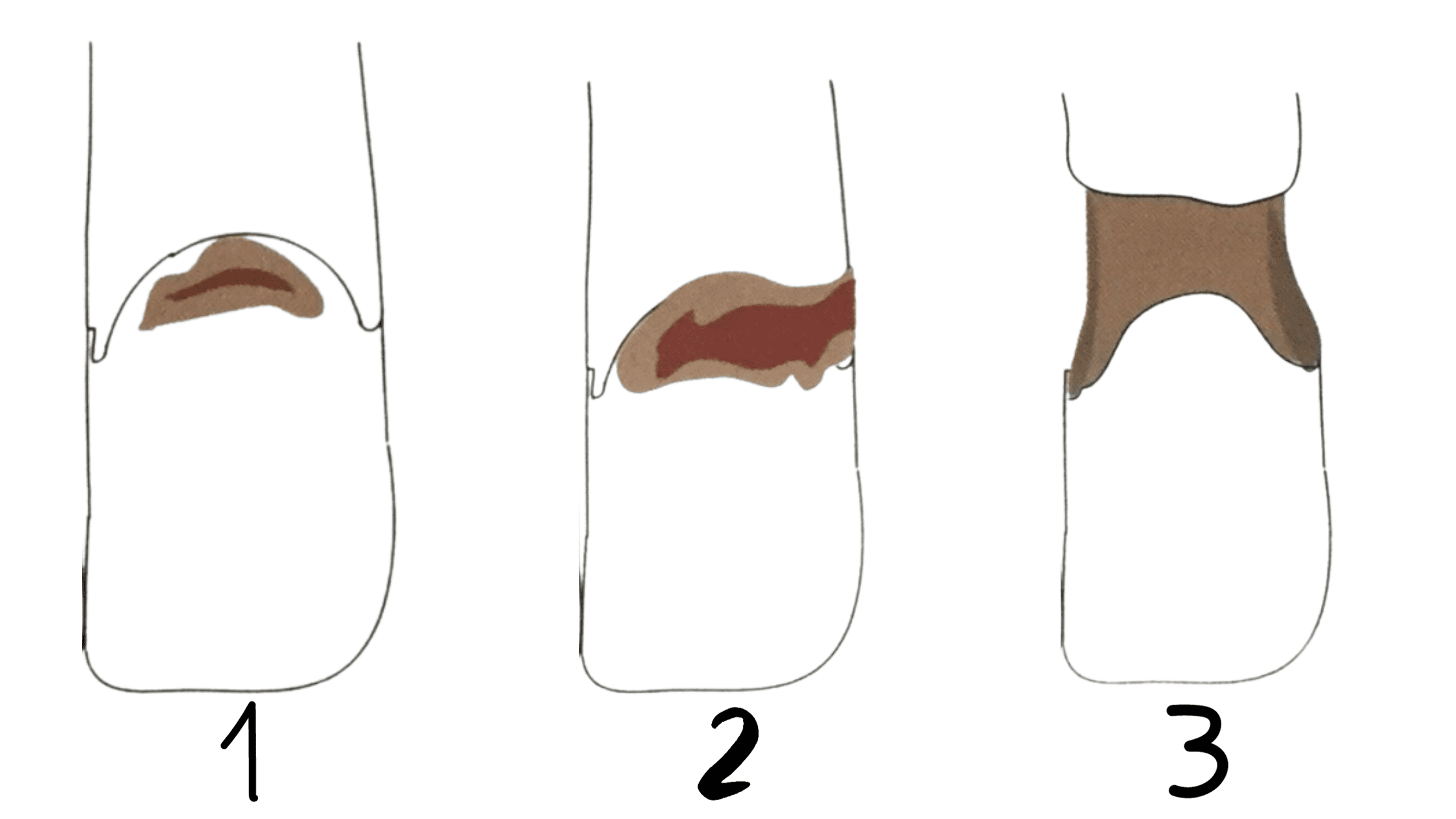
Tooth decay near the gum line can spread quickly and aggressively if you don’t treat it.
Because it starts at the base of the tooth, this type of decay can weaken the tooth’s foundation — increasing the risk of fracture or even tooth loss.
Think of it like chopping down a tree with an axe: the decay can work its way deeper and along the gum line, slowly destroying more of your tooth structure.
At advanced stages, the tooth becomes unstable and may crack or break off completely.
Here are the main stages of tooth decay:
- Initial Spot: Decay begins as a small, superficial area with no visible holes.
- Surface Breakdown: The decay grows deeper and larger, eventually forming a visible cavity.
- Nerve Involvement: If untreated, the cavity can reach the tooth’s nerve, causing pain, infection, abscess, and possibly tooth loss.
Early Signs of Tooth Decay at the Gum Line
In the beginning, tooth decay on the outer enamel surface can be hard to notice. It often starts as a light white spot with a slightly chalky texture. As the decay worsens, it becomes more visible and darker.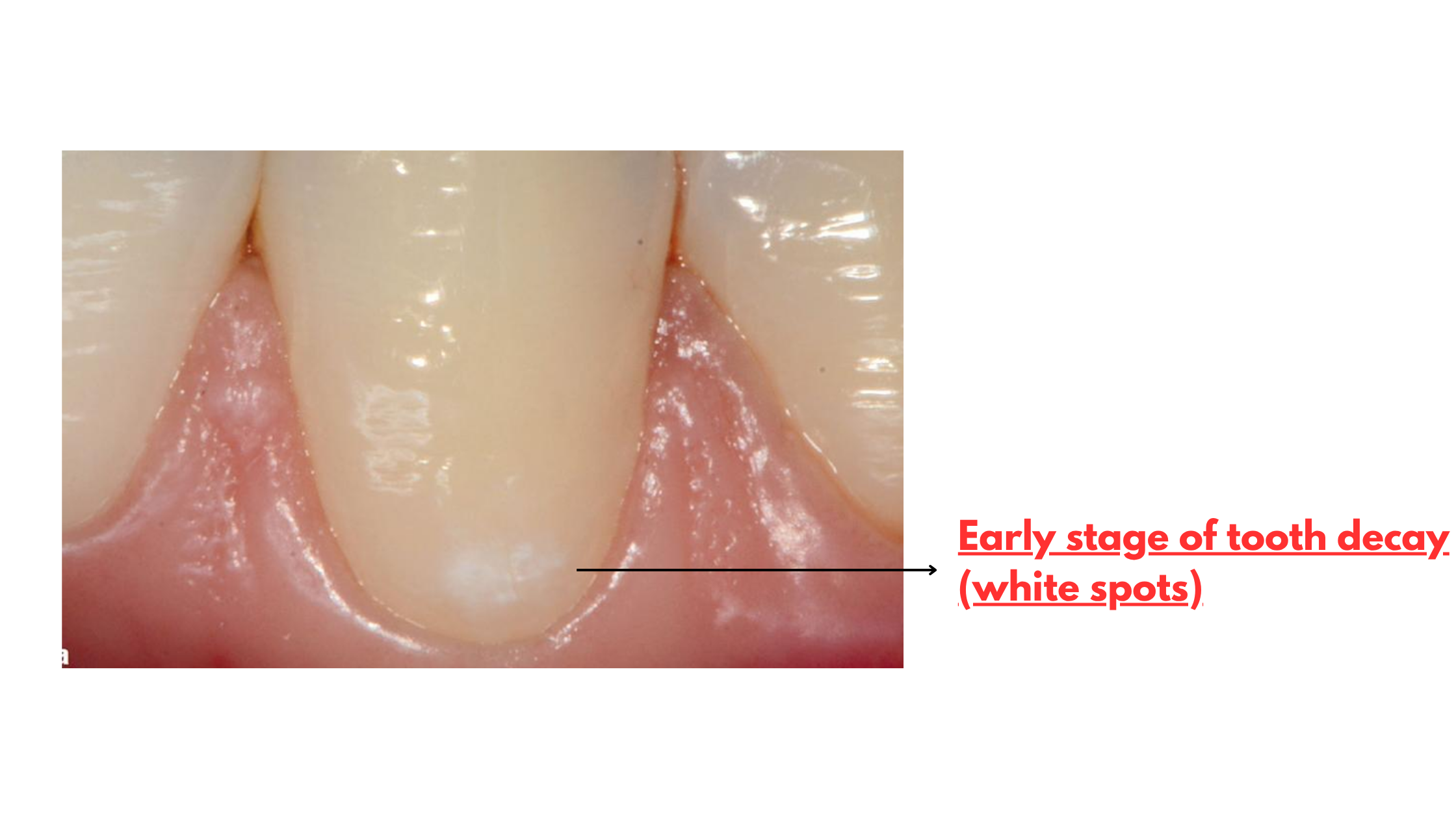
Here are some signs to watch for:
- Yellow or Brown Staining: As your tooth loses minerals and becomes porous, it can absorb stains from food and drinks. Early decay often looks yellow or brown. Over time, the discoloration may turn gray or black as the decay goes deeper.
- Duller Tooth Appearance: As minerals are lost, the tooth loses its shine and looks dull and lifeless under light.
- Increased Plaque Build-Up: Decayed areas become rough and porous, making it easier for plaque to stick and accumulate.
- Sensitivity to Hot or Cold: Feeling sharp sensitivity to hot or cold foods and drinks can mean the cavity has advanced and is getting closer to the tooth’s nerves.
- Visible Holes in the Tooth: In advanced stages, you may see actual holes or pits on the tooth surface. At this stage, the damage is irreversible. The only option is to have your dentist remove the decay and restore the tooth with a filling.
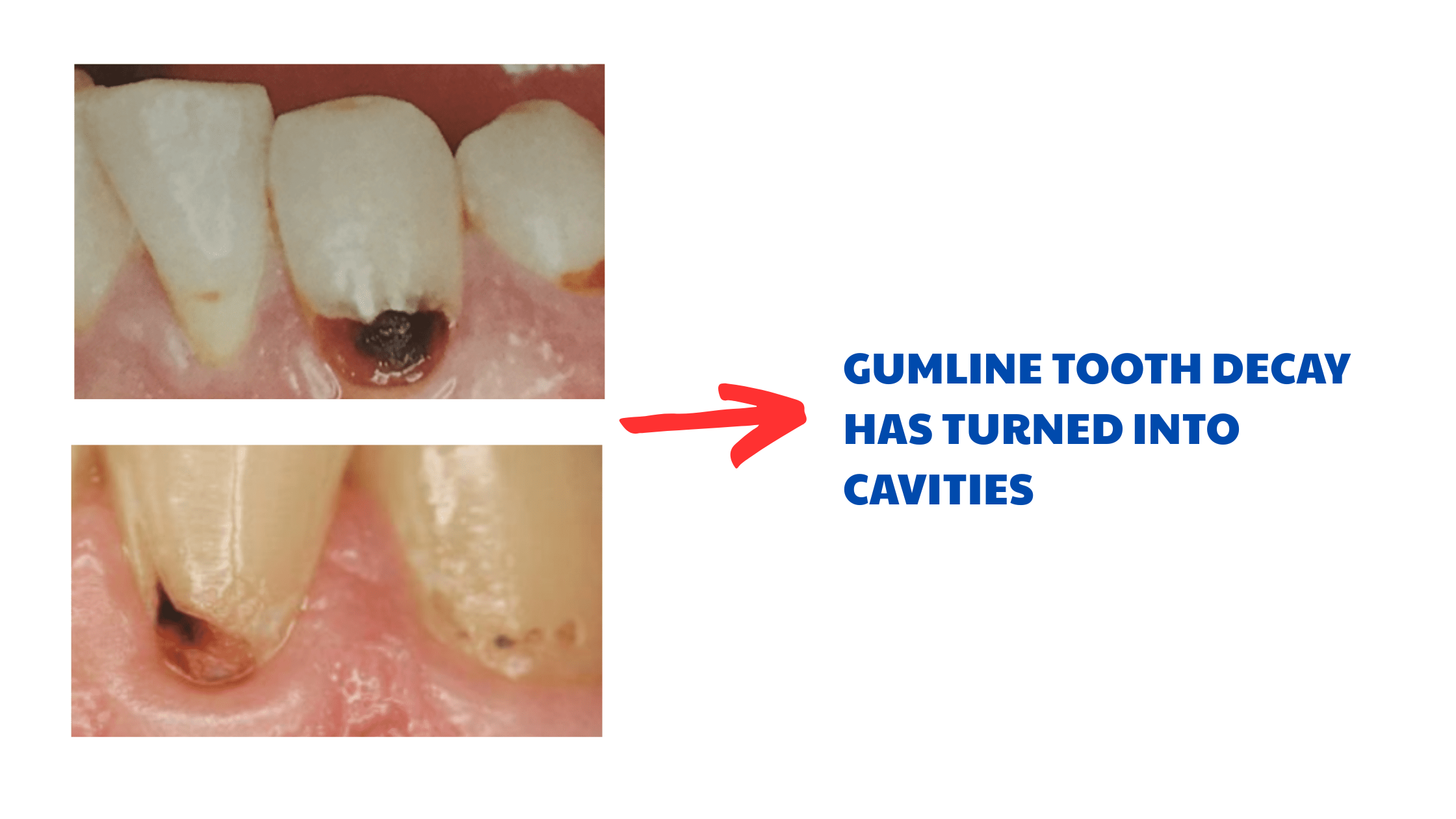
How to Stop Tooth Decay at the Gum Line Before It’s Too Late
If you catch tooth decay early — before it turns into a hole — you can stop it or even reverse the damage completely.Here’s what you can do:
Improve Your Oral Hygiene
Brush twice daily with a soft toothbrush using the proper technique, and don’t skip flossing. This helps remove plaque, the main culprit behind cavities.
Support Your Saliva
Stay hydrated and avoid snacking between meals to let saliva do its job. Chewing sugar-free gum with xylitol between meals can also help stimulate saliva production.
Use Remineralizing Products
Besides your fluoride toothpaste, adding a remineralizing product, like a gel or mouthwash, to your daily routine can boost the remineralization process and help reverse early signs of tooth decay more effectively.
Reduce Sugary Foods and Snacking
Cutting back on sugary snacks and drinks slows the growth of cavity-causing bacteria and lowers acid levels in your mouth. However, if the decay has progressed and a hole has formed, the damage is no longer treatable at home. At this point, treatment at your dentist is the only option.
Professional Treatment Options
When tooth decay at the gum line progresses to an advanced stage — forming a cavity or hole — the treatment is similar to that for other types of decay.Here are the main options:
1. Do Nothing and Monitor
This option is only suitable if the decay is arrested — meaning it has stopped progressing. It shouldn't pose any cosmetic problems either.
Arrested decay usually feels hard, looks smooth, and appears dark brown or black.
If that's the case, your dentist may recommend a watch-and-wait approach along with preventive care, such as professional cleanings, fluoride applications, and remineralizing treatments.
2. Remove the Decay and Restore
If the decay is still active and progressing, your dentist will remove the damaged area and restore the tooth. This may involve a filling for small lesions or a crown for more extensive damage.
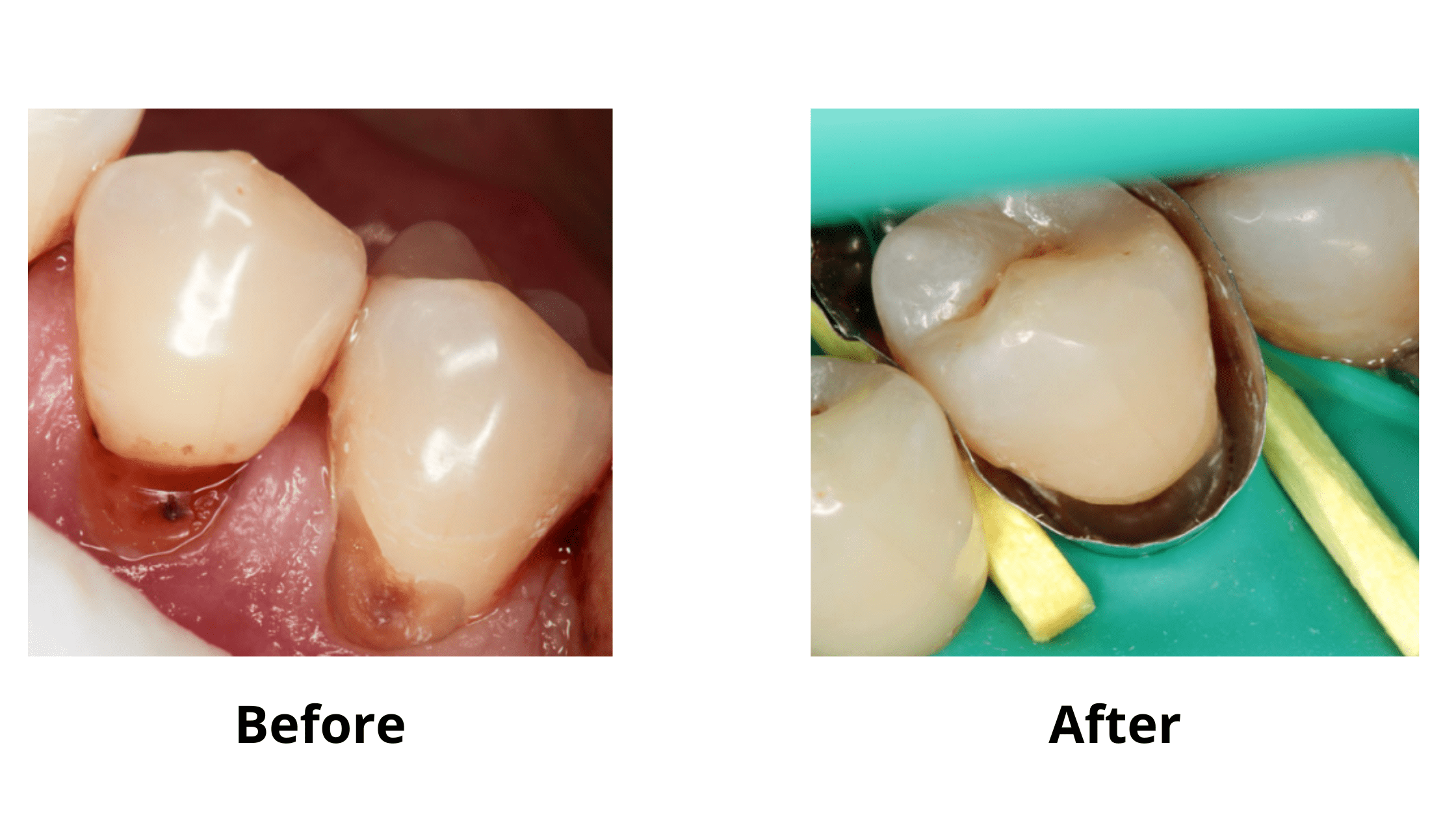
3. Root Canal and Restoration
If the decay has reached the tooth’s nerve, a root canal will be necessary before the tooth can be restored with a filling or crown.
4. Extraction
In severe cases where the tooth is too damaged to be saved, extraction may be the only option.
Takeaway
Tooth decay at the gum line becomes more common with age, especially as the gums begin to recede. However, it can also show up in younger adults — and when it does, it’s often a sign of a higher overall risk for cavities.If you notice decay in this area, don’t wait. Gum line cavities can progress quickly and become harder (and more expensive) to treat the longer you delay.
The sooner you catch it, the simpler and less invasive the treatment will be, and also the less costly.